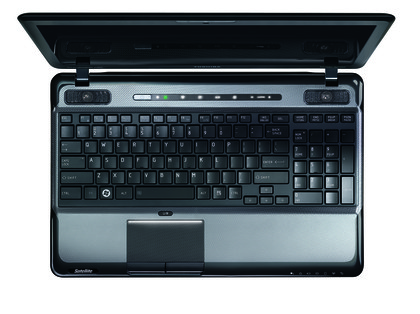Why you can trust TechRadar
Of course the key selling point of the Toshiba Satellite A665-11Z is its 3D screen, and this is where it truly excels. Using the same Nvidia 3D Vision technology used by the Asus G51JX and the Rock Xtreme 680, the Toshiba employs a set of active shutter glasses to create its 3D effect. Far more effective and far less nausea-inducing than the polarised screen of the Acer Aspire 5738DZG, the 3D effect it creates is nothing less than stunning.
Setting up the Nvidia 3D Vision system is easy, and is achieved by following a simple step-by-step wizard. You begin by connecting the compact infrared receiver to an available USB port on the Toshiba Satellite A665-11Z's chassis.
You then put on the battery-powered, active shutter 3D glasses and use the wizard to walk you through the process of testing that both devices are comfortably synchronizing with one another to create the necessary 3D effect.

Nvidia's active shutter glasses work by lightening and darkening the lens covering each eye, in time with the refresh rate of the Toshiba Satellite A665-11Z's 15.6-inch screen. Synchronising via the accompanying infrared receiver, the screen shows two different images in quick succession – far too fast for the naked eye to see – and by letting each eye see each image in turn, your brain is tricked into seeing a three-dimensional image that does not exist.
A simple concept on paper, the technology itself is extremely complex and works very well.
When viewing 3D photos and movies, the appearance of depth is so effective that images literally leap out of the Toshiba Satellite A665-11Z's screen. Where the technology is most effective, however, is when gaming.
With a huge range of fantastic 3D Vision capable games currently available, including Batman: Arkham Asylum and Resident Evil 5, games have never been more immersive, with enemies popping out of the screen and scenery whizzing by with dizzying depth. The effect is stunning, but one minor flaw detracts from the overall experience.
Sign up for breaking news, reviews, opinion, top tech deals, and more.
With the active shutter glasses providing a barrier between your eyes and the screen, the vibrancy of the Toshiba Satellite A665-11Z's screen is greatly reduced. This renders the screen disappointingly flat and colourless, reducing the overall impact of the 3D experience. This is a known flaw of Nvidia's 3D Vision technology, however, and not a flaw of the Toshiba Satellite A665-11Z itself. Nvidia is aware of this limitation of its technology and assures us that it is working hard to rectify the situation for future iterations.
Thankfully, when the glasses come off, the Toshiba Satellite A665-11Z's 15.6-inch screen is stunning. Combining impressive brightness and colour reproduction with striking contrast and deep black levels, photos, videos and games look fantastic.
While we're a little disappointed about the 1366 x 768 pixel resolution and would have preferred a Full HD screen, images are rendered sharply enough for enjoying 720p high-definition content. Viewing angles are a little limited, however, so you have to view the screen head-on to get the best quality images.
The lack of a Full HD resolution is exacerbated by Toshiba's inclusion of a Blu-ray compatible optical drive. While high-definition movies look great on the Satellite A665-11Z's screen, much of the impact of the HD video is lost by its lack of 1080p support. The Blu-ray drive impresses, however, as it doubles as a Blu-ray rewriter, letting you burn as much as 50GB of data to compatible dual-layer discs. Accessing and burning DVDs and CDs is also possible.
Not that you'll need to back up data to disc on a regular basis, as the Toshiba Satellite A665-11Z features a capacious 500GB hard drive as standard. While not quite as impressive as the 1.2TB of storage offered by more expensive rivals such as the Acer Aspire Ethos it will provide ample storage for most people and let you store large collections of photos, music, videos and games with ease.
The drive is also shock-protected, parking the disk heads when the laptop is bumped to prevent damage to your data.
Where the Toshiba Satellite A665-11Z again impresses is its staggering performance. Powered by a quad-core Intel Core i7-740QM processor and 4096MB of high-speed DDR3 memory – upgradeable to 8192MB – the Toshiba makes light work of even the most demanding software. With the processor running at 1.73GHz, but able to ramp up to 2.93GHz when necessary, applications are dispatched with ease, and Intel's Hyper-Threading technology ensures that multi-tasking is equally smooth with no discernable slowdown.
Graphics are similarly capable and roughly in line with Toshiba's own Qosmio X500 range. The Nvidia GeForce GTS 350M graphics card lets you edit photos and videos with ease and even runs the latest games with suitable aplomb. High-definition video is also processed smoothly, backing up the Blu-ray drive nicely.
This is not a gaming laptop in the truest sense of the word, however, as it lacks the graphics performance of such cutting-edge rivals as the Alienware M17x.
Current page: Toshiba Satellite A665-11Z: Performance
Prev Page Toshiba Satellite A665-11Z: Specification Next Page Toshiba Satellite A665-11Z: Verdict